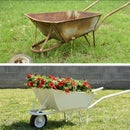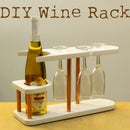Introduction: Concrete and Acrylic LED Lamp With a Wooden Base
In this Instructable I’m going to show you how I made a concrete and acrylic LED lamp with a wooden base.
Here I’ll try to embed tiny acrylic pieces into concrete, which will guide the light from the LED light source to the concrete surface.
Materials:
- Acrylic sheet https://amzn.to/2HmrgDf
- Quikrete https://amzn.to/2JiYW5j
- Styrofoam board https://amzn.to/2JmZsj0
- Epoxy https://amzn.to/2Gnkltj
- Masking tape https://amzn.to/2qTT4rH
- Wood glue https://amzn.to/2FaFKEq
- RGB LED strip light https://amzn.to/2vH2cFM
- Silicone pads https://amzn.to/2JfumJV
- Shellac https://amzn.to/2HWClMI
- Spray paint for concrete https://amzn.to/2F9Vmbr
Tools:
- Cordless drill https://amzn.to/2J4hJlN
- Random orbit sander https://amzn.to/2JlKObN
- Coping saw https://amzn.to/2IeBfuC
- Soldering iron https://amzn.to/2Jjvpsc
- Glue gun https://amzn.to/2qTbjO1
- Forstner drill bits https://amzn.to/2GlCwn6
- Metal ruler https://amzn.to/2HmJXLk
- Utility knife https://amzn.to/2HmJXLk
Step 1: Cutting the Acrylic and the Styrofoam.
The acrylic piece that I’m using is 5 mm thick. I cut around 60 tiny pieces of it on my table saw using the crosscut sled.
For the mold I’m using 10 mm thick Styrofoam board. I marked all the dimensions and cut it using a metal ruler and a utility knife for more precision.
Step 2: Inserting the Acrylic Into the Styrofoam.
The most complicated thing I need to do is combining acrylic and concrete. But, I found a pretty good way to do that.
I created random holes into each Styrofoam piece with a hot screwdriver, which I heated up onto a portable gas stove.
Then, I inserted the acrylic into the smallest Styrofoam piece, which will actually be the bottom of the mold, and secured them in place with zip tie.
Step 3: Bending the Acrylic Pieces.
When it comes to inserting the acrylic into the sides of the mold, there’s one important step that will make that possible. And that step is bending the acrylic.
So, I bent the acrylic using a simple technique that requires only a gas stove and a lighter. I turned the gas stove on, reduced the heat and placed a piece of acrylic above, waiting for about 20 seconds until it softened so that I can easily bend it.
This way I bent all the pieces of acrylic and inserted them into the holes that I previously made. To make the next step easier I tied them up with zip ties.
Now, I can secure the acrylic in place with hot glue.
Applying cooking oil over the Styrofoam surface will prevent the concrete from sticking to the mold.
Step 4: Assembling the Mold.
Finally, I can assemble the mold.
Instead using an adhesive for Styrofoam, I went with toothpicks and hot glue. The toothpicks served as dowels, and the hot glue helped me fill in all the gaps between the joints.
Additionally, I used a corner clamp, a masking tape and a duct tape to secure the mold.
Step 5: Mixing Up Some Concrete.
Now I can mix up some concrete. I mixed one part sand with one part cement, and gradually added water until I got a thick consistency. Then, I poured the concrete into the mold. Here I needed to vibrate the mold by hand to fill in all the voids.
I poured concrete into the mold until it reached around 20 cm height. At the end, I additionally vibrated the mold to release the air pockets.
When I was done, I let the concrete cure for 2 days.
Step 6: Removing the Mold and Cutting the Extra Length of the Acrylic.
Removing the mold was very easy, I only had a difficulty with the hot glue which stuck onto the acrylic. But, I removed that easily with a utility knife.
All acrylic pieces need to be flush with the concrete surface. So, I cut all the parts of the acrylic that were sticking out of the concrete with a coping saw.
Also, I needed to cut the extra length of the acrylic on the bottom, and left only 3 cm of it.
Then, I sanded the concrete surface with my random orbit sander to remove all the imperfections.
Step 7: Creating the Wooden Base.
Now, I can move on to the wooden base. The base I made out of beech wood. I cut 4 identical pieces at a 45 degree angle in order to get a clean look, because I want the focus to be on the concrete and the acrylic.
When I placed the wooden pieces onto the concrete, I realized that some of the acrylic pieces were closer to the edge which doesn’t allow the wood to sit flush with the concrete. So, I needed to remove parts of the thickness of the wood on the crosscut sled.
It took me a while until I finished, because I needed to adjust the blade all the time, but I was really satisfied with the end result. I made just enough space for the acrylic to fit inside the base.
On the bottom of the base I’ll attach a fiberboard piece, so I need to make rabbets on each wooden piece, 5 mm wide and 7 mm deep. These rabbets will give a cleaner look to the base.
Step 8: Making Space for the LED Controller.
I took the wooden piece that will go on the back side of the lamp, and made a space for the LED controller. I drilled two holes, on for the power plug, and the other for the infrared receiver. On the other side I made enough space for the controller with a Forstner bit and a chisel.
Next, I’m going to glue up the base. Using masking tape as a clamp when gluing mitered corners together works pretty well.
Step 9: Applying Finish to the Concrete and the Wood.
While the base is drying, I can protect the concrete surface with a transparent finish. First, I cleaned the surface with a wet rug, and then sprayed all over the concrete.
Now I can go back to the base.
One corner had a gap on the joint, so I filled in the gap with a combination of wood glue and saw dust. I was surprised of how good it turned out.
After that, I hand sanded the base, first with 120, and then with 220 grit sandpaper. To protect the wood, I applied one coat of transparent finish.
Step 10: Installing the Light.
Next, I can work on the light. I cut 1 meter RGB LED strip on the predetermined cutting points. Then, I took the connector, stripped off the wires, and soldered them on the LED strip appropriately. I’m using 12 V power adapter.
Before gluing everything in place, I made a test to see how it works.
Everything was OK, so I hot glued the controller and the infrared receiver in place.
Then, I stuck the LED strip into the base.
Step 11: Joining All the Parts Together.
To cover the bottom I used 3 mm thick fiberboard, and attached it only with 2 screws, so that I can easily remove it if needed.
All the pieces are ready for assembly. I applied a large amount of epoxy to make a strong connection between the wood and the concrete.
The last thing I need to do is to attach silicone cabinet bumpers on the bottom to protect the surface where the lamp will be placed on.
Now I can insert the plug, turn the lamp on, and enjoy the fascinating effect.
Don't forget to watch the video for full experience!
If you like this project please follow me on social media and subscribe to my YouTube channel.
- YouTube: https://www.youtube.com/CreativityHero
- Website: https://creativityhero.com/
- Instagram: https://www.instagram.com/creativity.hero/
- Facebook: https://www.facebook.com/CreativityHero/
- Pinterest: https://www.pinterest.com/creativityhero/
Thanks! :D






